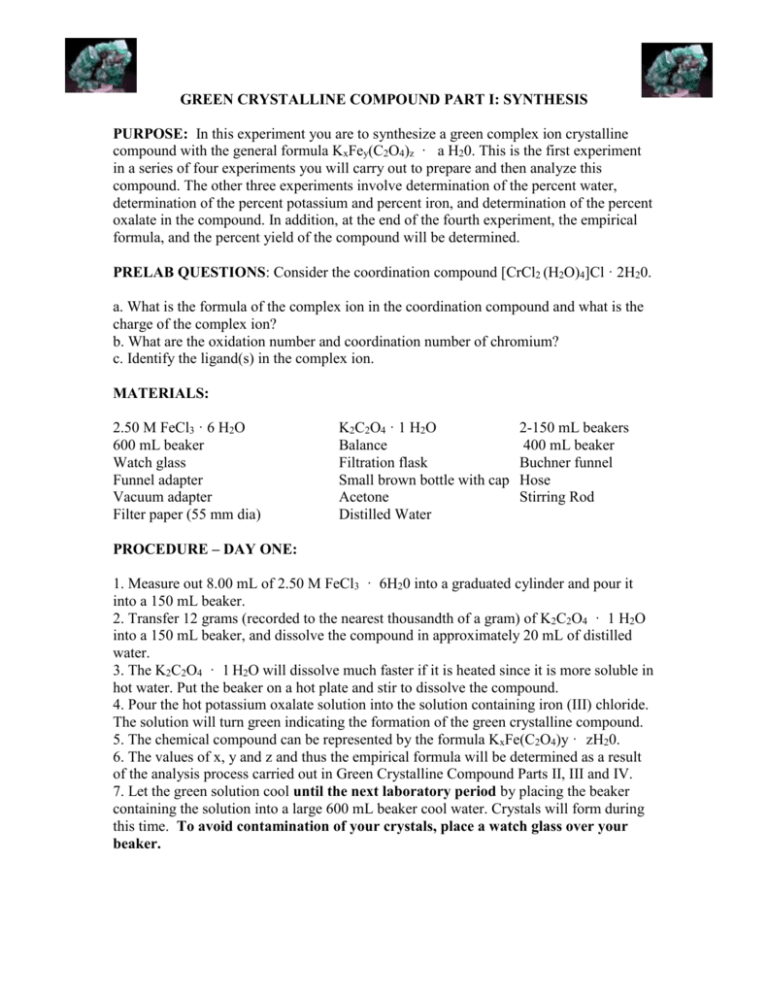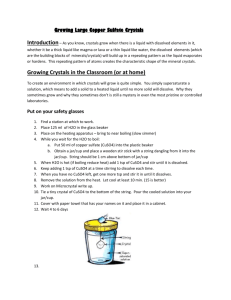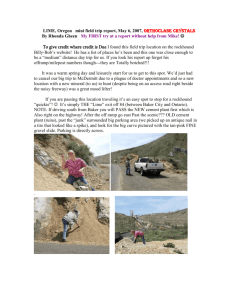Green Crystalline Compound Synthesis Lab Manual
advertisement

GREEN CRYSTALLINE COMPOUND PART I: SYNTHESIS PURPOSE: In this experiment you are to synthesize a green complex ion crystalline compound with the general formula KxFey(C2O4)z · a H20. This is the first experiment in a series of four experiments you will carry out to prepare and then analyze this compound. The other three experiments involve determination of the percent water, determination of the percent potassium and percent iron, and determination of the percent oxalate in the compound. In addition, at the end of the fourth experiment, the empirical formula, and the percent yield of the compound will be determined. PRELAB QUESTIONS: Consider the coordination compound [CrCl2 (H2O)4]Cl · 2H20. a. What is the formula of the complex ion in the coordination compound and what is the charge of the complex ion? b. What are the oxidation number and coordination number of chromium? c. Identify the ligand(s) in the complex ion. MATERIALS: 2.50 M FeCl3 · 6 H2O 600 mL beaker Watch glass Funnel adapter Vacuum adapter Filter paper (55 mm dia) K2C2O4 · 1 H2O Balance Filtration flask Small brown bottle with cap Acetone Distilled Water 2-150 mL beakers 400 mL beaker Buchner funnel Hose Stirring Rod PROCEDURE – DAY ONE: 1. Measure out 8.00 mL of 2.50 M FeCl3 · 6H20 into a graduated cylinder and pour it into a 150 mL beaker. 2. Transfer 12 grams (recorded to the nearest thousandth of a gram) of K2C2O4 · 1 H2O into a 150 mL beaker, and dissolve the compound in approximately 20 mL of distilled water. 3. The K2C2O4 · 1 H2O will dissolve much faster if it is heated since it is more soluble in hot water. Put the beaker on a hot plate and stir to dissolve the compound. 4. Pour the hot potassium oxalate solution into the solution containing iron (III) chloride. The solution will turn green indicating the formation of the green crystalline compound. 5. The chemical compound can be represented by the formula KxFe(C2O4)y · zH20. 6. The values of x, y and z and thus the empirical formula will be determined as a result of the analysis process carried out in Green Crystalline Compound Parts II, III and IV. 7. Let the green solution cool until the next laboratory period by placing the beaker containing the solution into a large 600 mL beaker cool water. Crystals will form during this time. To avoid contamination of your crystals, place a watch glass over your beaker. PROCEDURE – DAY TWO: 8. The crystals will form in a reaction mixture that contains excess reactants and other miscellaneous products. Pour off the solvent containing excess reactants and other miscellaneous products and discard it. 9. Even after the liquid has been poured off there will be impurities on the crystals. The crystals will need to undergo a recrystallization step to purify them. 10. Add 20 mL of distilled water and heat on a hot plate with stirring to dissolve the crystals. 11. Set the beaker containing the crystalline solution in a lab drawer until the next laboratory period to allow crystals to reform. Put a watch glass over the beaker to cover it and prevent impurities. PROCEDURE – DAY THREE: 12. Filter the crystals using a Buchner funnel and filter flask to carry out a vacuum filtration. 13. Wash the crystals twice with 5 mL portions of ice water. Next, wash the crystals twice with 5 mL portions of acetone to help dry them out. 14. Transfer the crystals to a clean, dry 400 mL beaker and put in your lab drawer to air dry. When the crystals are dry, transfer them to a pre-massed brown bottle and determine the mass to the nearest 0.001 g. Find the mass of the crystals you collected. You will need this mass and the masses of FeCl3 · 6H2O and K2C2O4 · H2O reacted to calculate theoretical yield and percent yield for Green Crystalline Compound Part IV. 15. Store the crystals in the capped brown bottle in your lab drawer. YOU WILL USE THESE CRYSTALS ALL YEAR LONG. DATA AND CALCULATIONS: Include the following in the data portion of your lab write up: Volume of FeCl3 · 6H2O, moles of FeCl3 · 6H2O, mass of K2C2O4 · 1 H2O, moles of K2C2O4 · H2O, mass of empty brown bottle plus green crystals, mass of empty brown bottle, mass of green crystals CONCLUSIONS: 1. Why is it necessary to cool the solution containing the green crystalline compound in order to get crystals to form? 2. What could happen if the complex crystals were allowed to reform without pouring off the solvent in procedure step 8)? 3. Why can we not calculate percentage yield at this point in the series of Green Crystal Labs? Remember: Percentage yield = theoretical mass of crystal obtained actual mass of crystal obtained








